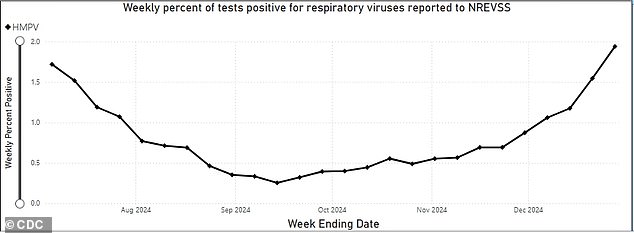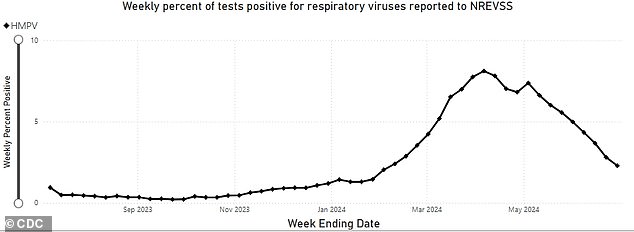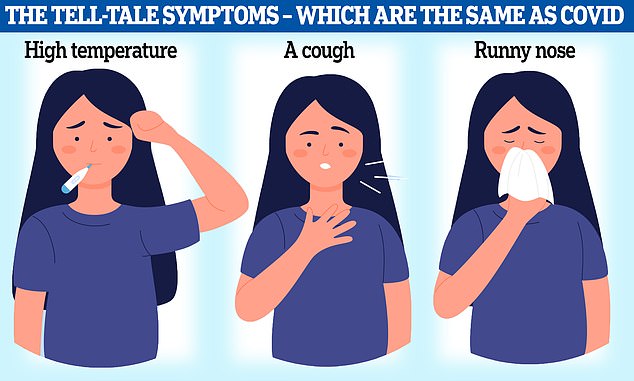Western experts have publicly called on China to be more transparent about a viral outbreak overwhelming its hospitals, as data shows the virus is growing in the United States.
Beijing has yet to comment on images of crowded waiting rooms and wards posted on social media or reports of crematoriums and funeral homes packed with bodies.
The outbreak in China is believed to be being fueled by the relatively unknown human metapneumovirus (HPMV) virus, which typically causes cold-like symptoms such as nasal congestion, headache, chills and tiredness.
Dr Sanjaya Senanayake, associate professor of medicine and infectious diseases expert at the Australian National University, said it was “vital that China shared its data on this outbreak in a timely manner”, including “data on who is becoming infected”.
He added: ‘In addition, we will need genomic data to confirm that HMPV is the culprit and that there is no significant mutation of concern. These genomic data will also guide vaccine development.’
China’s silence has led some to fear similarities with the 2019 Covid outbreak, which was initially downplayed by Beijing.
His warning comes as the United States experiences its own surge in HMPV cases, with percentages of positive tests doubling from early to late December.
According to the latest CDC data, just under 300 positive tests were reported during the last week of December, the latest figures available.
The above is a screenshot of a video posted online that claims to show an overwhelmed hospital unit in China.

The CDC graph above shows an increase in positive HMPV tests in late December 2024.
HMPV first emerged in 2001 and typically causes symptoms of a common cold.
But more serious symptoms, such as bronchitis, bronchiolitis and pneumonia, can occur, and patients experience shortness of breath, severe cough or wheezing.
Children, the elderly, and immunocompromised patients are at greatest risk of serious complications.
Because the virus is usually mild, its exact mortality rate is unknown. But experts estimate that between 10 and 30 percent of patients hospitalized with HMPV die in the United States.
Dr. Senanayake warned that the rise in HMPV cases in China is similar to a “bad flu season” in the US and was not likely to become a global problem.
He said: “At this point, China is most likely experiencing a bad HMPV season, just as in some years we have an overwhelming flu season.”
“This could be due to a combination of viral and behavioral factors, but it should calm down.”
Vasso Apostolopoulos, professor of immunology at RMIT University in Australia, said the rise in cases and increasing pressure on health systems in densely populated regions like China show the need for greater vigilance.
He said: “Ensuring effective monitoring and timely responses will be key to mitigating the public health risks of this outbreak.”
The Chinese CDC has urged people to take precautions such as washing their hands, but has rejected claims that hospitals will be overwhelmed.
Chinese Foreign Ministry spokesperson Mao Ning said: “Respiratory infections tend to peak during the winter season.
“Illnesses appear to be less severe and spread on a smaller scale than last year.”
Like Covid, HMPV spreads through respiratory droplets that circulate in the air when a person coughs or sneezes. Close personal contact, such as shaking hands and touching contaminated surfaces, can also spread the disease.
Researchers estimate that one in 10 respiratory illnesses in American children is caused by HMPV.
According to the CDC, the most common symptoms are fever, cough, congestion, and difficulty breathing.
The CDC estimates that 20,000 children under age five in the U.S. are hospitalized with HMPV each year.
There are no vaccines or specific treatments for the disease.
Professor John Tregoning, an expert in vaccine immunology at Imperial College London, said: “HMPV (human metapneumovirus) is not a new virus – it was first isolated in 2001 but has most likely been circulating for a long time. longer”.
‘It has very similar symptoms (at least in children) to RSV (respiratory syncytial virus). It is part of the cocktail of winter viruses to which we are exposed.
‘As with all respiratory viruses, there will be a range of symptoms and severity. Risk factors will include age (either very young or very old) and underlying immunosuppression.
‘Like other viruses, it will be transmitted through coughing, sneezing and droplets. Protecting yourself by being in a well-ventilated place, covering your mouth when coughing and washing your hands will be of great help.
“It will present in the same way as the flu, sars-cov-2 and RSV, so the same advice applies to those affected: rest, drink fluids and try not to infect others.”

The CDC graph above shows HMPV positive test rates from August 2023 to June 2024. Positive test rates appear lower this time last year.


The above are clips from videos claiming to show overwhelmed hospitals in China.

Experts have warned that HMPV, which produces flu-like symptoms, can remain in the body for days and can therefore easily be transmitted to other people.
Professor Jill Carr, a virologist at Flinders University’s School of Medicine and Public Health in Australia, warned that the current outbreak in China was unlikely to cause a global crisis.
She said: “This is very different to the COVID-19 pandemic, where the virus was completely new in humans and emerged from an animal contagion and spread to pandemic levels because there were no previous exposures or protective immunity in the community.
“The scientific community also has some understanding of the genetic diversity and epidemiology of HPMV, the type of impact the virus has on the lungs, and the established laboratory testing methods – again, very different from the COVID-19 pandemic. 19, where a new lung disease was detected. As we have seen, there was little information about how the virus can vary and spread and we had no initial diagnostic tests.’
Andrew Easton, professor of virology at the University of Warwick in the United Kingdom, said Living science: ‘HMPV has been recognized as a major problem in at-risk populations worldwide since the beginning of the century, when it was first discovered.
“That risk has not changed significantly in the last almost 25 years.”
According to the National Respiratory and Enteric Virus Surveillance System (NREVSS), a CDC database, HMPV cases in the United States are increasing compared to this time last year.
Data for the week of Dec. 28, the latest available, shows a test positivity rate of 1.9 percent. Of about 13,800 total tests for that week, that adds up to just under 300 confirmed cases.
The test positivity rate for the week of Nov. 30 was 0.9, half that of the following month.
And this time last year, the CDC recorded a testing positivity rate of 1.2 percent.
However, Paul Hunter, a professor of medicine at the University of East Anglia in the United Kingdom, said it may be difficult to detect year-on-year increases because HMPV is detected with molecular tests such as PCR tests, which are used to detect Covid.
He said: “One of the problems with these types of infection is that they are diagnosed more frequently as we move towards molecular diagnostic panels, so it is not always easy to know whether year-on-year increases are due to real increases. or simply because we are diagnosing a higher proportion of infections.
He noted that while the UK has seen a “marked increase in recent weeks” similar to the US, cases are roughly similar to this time last year.
He said: “So overall I don’t think there is currently any sign of a more serious global problem.”
Dr Jacqueline Stephens, senior lecturer in public health at Flinders University in Australia, said: “I think we are more cautious about outbreaks now.
“Everyone is very alert and you hear the term human metapneumovirus and it sounds a little scary.”


